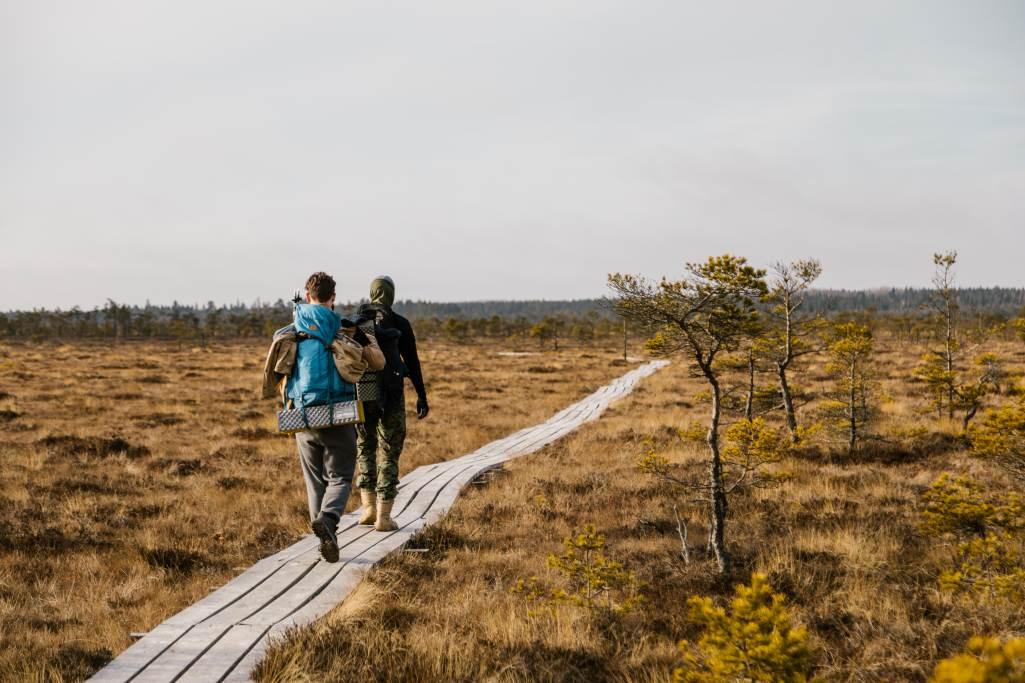Nature is without a doubt, the true gold of Latvia. The four seasons in the temperate climatic zone of Latvia bring you a mixture of vicious cold and sweltering heat. There is no shortage of nature diversity in Latvia; although the country is not that big, it’s covered in forests, fields, bogs and marshes. A bog is a part of the land’s surface that has permanent or periodic moisture and specific flora and fauna. Bogs are water reservoirs and play a very important role in the water cycle in nature. Bogs take up 4-5% of the territory of the country. In total, 5078 moors are registered in Latvia, and 1.5% of them exceed 1000 ha. While in some European countries the natural bogs have not been preserved at all, in Latvia they are not only preserved, but also made available for walks. And walks on bog trails are especially wonderful: scenic, silent and magical. Since ancient times, the bog has tricked, scared and tempted people; various fog-entwined legends and tales have emerged about bogs. Also, this part of nature requires a lot of caution because of the tricky quagmires, will-o’-the-wisps, intoxicating scents and peculiar sounds.
Is it time for a walk in the bog? Yes! Now you only need to choose the most desired route.
Dunika bog trail
Dunika bog trail is one that takes your breath away, as all along the trail you can observe a unique landscape: small lakes, islets, and hornbeams. At the southern end of the bog’s trail is the Lukna hornbeam grove, which is currently the only grove of its kind in Latvia. It is almost a century and a half old, and in some places the old trees have spread their branches as high as a six-storey building. The length of the trail is 5.5 km, but it should be noted that it is linear. Weather conditions should also be taken into account - during the rain and in winter, the boardwalk can be slippery and there are large gaps between the boards where it’s easy to stumble.
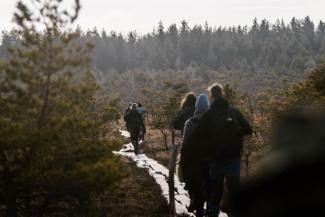
The Great Ķemeri bog trail
The Great Ķemeri bog is one of the largest in Latvia; its area is 5 000 hectares. The bog is around 8 000 years old! It is rich in countless lakes and islets, and sulphur waters form underneath the surface. On the other hand, the soil in the bog is poor in nutrients, acidic and in many places, too wet. Most trees cannot survive in such harsh conditions, so there are only a few tree species - pines and birches - and they do not grow as big and thick as in the forest. Perhaps that is why a walk in this bog is particularly interesting. Also, the Great Ķemeri bog is a must-visit spot for every ornithology enthusiast, as it is an excellent place for bird watching during the migration season. The trail of the Great Ķemeri bog will allow you to easily and safely get to know this otherwise difficult-to-access kingdom. The boardwalk is built of wooden planks and has two routes. The small one (approx. 1.4 kilometres) will take you to the first picturesque lakes, while the big one (approx. 3.4 kilometres) will allow you to view the landscape from above by climbing the observation tower.
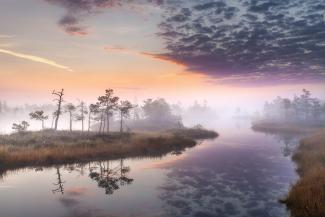
Vasenieki marsh trail
The Vasenieki marsh trail is located in the nature reserve “Stiklu purvi” (Glass marshes), which was created in 1977 and is the largest complex of high marshes in Kurzeme. The four-kilometre long trail winds along picturesque marsh pools and beautiful marsh lakes. Currently, visitors have access to a completely new viewing platform that allows you to enjoy the landscape of the marsh from a height of six metres, while the total length of the trail is 4 km. The marsh walk offers both a natural marsh full of life and a degraded marsh landscape coming into view once you set foot on the trail, as you walk past ditches which were once made to prepare the marsh for peat development but are now blocked to restore the water regime.
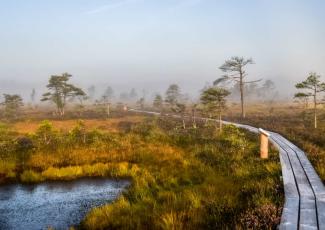
Niedrāji-Pilka bog trail
The Niedrāji-Pilka bog trail takes you to the bog island, where a viewing platform has been created near small lakes. As you stroll on, it will certainly be hard to believe that there is a six-metre-thick layer of peat under your feet, while even the pine trees that have not reached human height can be more than 100 years old. In addition, after the hike, it is worth inspecting the unusual objects of Livonian Sacrifice Caves near Svētupe and its surroundings: boat-shaped stone piles and energetic stones. The trail is 1 km long. At the other end of the trail, near small ponds, there is a viewing platform about 3 m high, which gives you the chance to observe not only the marsh, but also birds: cranes, herring gulls, kayaks and even such rare birds as the black stork, the little eagle and the grouse.
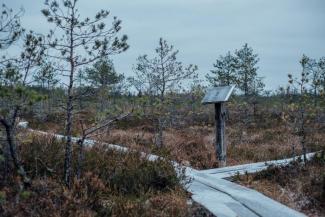
Cena moorland trail
Cena moorland is one of the largest bogs in Latvia; its untouched bog territory is included in two nature reserves, and it is also a Natura 2000 territory. Cena moorland formed due to disturbed run-off as a result of overland swamping. It has several smaller lakes, the largest of which is Lake Skaista, while in the southwest part there is a forest area. Peat is still extracted in part of the bog area. The diversity of the bog is a reason to go on the 5 km walk along the trail. In spring, the Cena moorland is particularly interesting for bird watchers. The bog is home to ten species of birds protected in Latvia and Europe, as well as several other species of small birds.

Teirumnīki bog trail
The Teirumnīki bog trail is located in Latgale between Lake Lubāns and Orenīši pond. The trail created for viewing the bog takes you along the picturesque Lake Teirumnīki and its soggy shore. The Teirumnīki bog trail allows you to get to know cranberries, sundews, horse-tails and other marsh plants. It is especially beautiful to visit this place in spring (May), when white and fragrant flowers bloom. The total length of the trail is 800 m of boardwalk and 700 m of forest path.
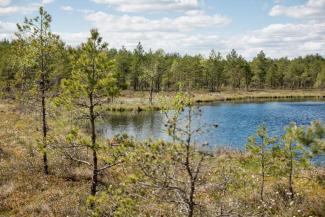
Andrupene bog trail
Short, but tempting - that’s the Andrupene bog trail. Behind the gates of the “Farmstead of Andrupene” museum, the Andrupene bog trail awaits nature lovers, offering a brief walk in fresh air and the chance to get to know the surroundings. Wooden steps and boardwalks lead through mosses, marsh tea and low little pines. This trail is perfect for those who don’t want to take on a long hike, but still want to experience the true magic, proximity and silence of a bog.

Seda bog trail
The Seda bog trail is one of the longest in Latvia, it’s total length is 5.5 km. The nature reserve “Sedas purvs” (Seda bog) is almost an uninhabited territory. As a result of peat extraction, a unique cultural landscape has emerged here, consisting of peat fields, bog ponds and a narrow-gauge railway used for peat development purposes. You can go on a walk and climb two observation towers in the bog. You can also fish from a boat in the bog ponds, or just enjoy a relaxing boat ride there.

Čužu bog trail
Near Kandava is the only shrubby cinquefoil grove in Latvia - a nature reserve “Čužu purvs” (Čužu bog). There you will find a nature trail along which you can observe shrubby cinquefoil growing on 96 ha. You can walk along the trail in all seasons, but it’s most effective in July and August when the shrubby cinquefoil blooms. However, if you visit the trail in spring and autumn, you have to be careful and wear appropriate shoes, because the trail may be wet or flooded in places. Čužu bog offers other rare plants as well: bird’s eye primroses, fragrant orchids, marsh helleborines, brown bog-rushes and others. The total length of the trail - 4.4 km. km.
